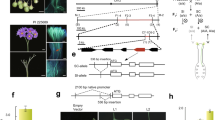Summary
S-locus inhibitor gene (Sli), which can inhibit gametophytic self-incompatibility in diploid potatoes and alter self-incompatible to self-compatible plants, was introduced by crossing into 32 diploid genotypes as females and its expression in the F1 and S1 progenies was investigated. We found that the expression of self-compatibility in the F1 hybrid progeny depended largely upon the female genotypes and partly upon the male genotypes (=Sli gene donor clones). Successful females produced hybrid plants, in which 67.1% of self-pollinated plants set S1 seeds. By second selfing upon the S1 plants, an average of 44.2% of self-pollinated plants were self-compatible. Unsuccessful females produced hybrids, most of which were self-incompatible or male-sterile. Restriction fragment patterns of chloroplast DNA (ctDNA) were able to distinguish successful females (S- or A-type ctDNA) from unsuccessful females (W- or T-type ctDNA). A ctDNA high-resolution marker analysis using seven microsatellites and H3 marker supported a higher degree of differentiation between the two groups of ctDNA types and implied a possible interaction between the cytoplasm and Sli gene function. However, it has been known that the cytoplasm having T-type ctDNA and that derived from Solanum demissum (haplotype 26 of W-type ctDNA) cause male sterility, and the present case with unsuccessful females were likely caused by male sterility rather than the failure of Sli gene function.
Similar content being viewed by others
References
Birhman, R.K. & K. Hosaka, 2000. Production of inbred progenies of diploid potatoes using an S-locus inhibitor (Sli) gene, and their characterization. Genome 43: 495–502.
Cipar, M.S., S.J. Peloquin & R.W. Hougas, 1964. Inheritance of incompatibility in hybrids between Solanum tuberosum haploids and diploid species. Euphytica 13: 163–172.
Dionne, L., 1961. Cytoplasmic sterility in derivatives of Solanum demissum. Amer Potao J 38: 117–120.
Douches, D.S., K. Ludlam & R. Freyre, 1991. Isozyme and plastid DNA assessment of pedigrees of nineteenth century potato cultivars. Theor Appl Genet 82: 195–200.
Grun, P., 1979. Evolution of the cultivated potato: A cytoplasmic analysis. In: J.G. Hawkes, R.N. Lester & A.D. Skelding (Eds.), The biology and taxonomy of the Solanaceae, pp. 655–665. Academic Press, London.
Grun, P. & J. Staub, 1979. Evolution of tetraploid cultigens from the view of cytoplasmic inheritance. In: Report of the Planning Conference on the Exploration, Taxonomy and Maintenance of Potato Germ Plasm III, pp. 141–152. International Potato Center, Lima, Peru.
Hosaka, K., 1986. Who is the mother of the potato? – restriction endonuclease analysis of chloroplast DNA of cultivated potatoes. Theor Appl Genet 72: 606–618.
Hosaka, K., 1993. Similar introduction and incorporation of potato chloroplast DNA in Japan and Europe. Jpn J Genet 68: 55–61.
Hosaka, K., 2003. T-type chloroplast DNA in Solanum tuberosum L. ssp. tuberosum was conferred from some populations of S. tarijense Hawkes. Am J Potato Res 80: 21–32.
Hosaka, K. & R.E. Hanneman Jr., 1988. Origin of chloroplast DNA diversity in the Andean potatoes. Theor Appl Genet 76: 333–340.
Hosaka, K. & R.E. Hanneman Jr., 1998. Genetics of self-compatibility in a self-incompatible wild diploid potato species Solanum chacoense. I. Detection of an S locus inhibitor (Sli) gene. Euphytica 99: 191–197.
Hougas, R.W. & S.J. Peloquin, 1962. Exploitation of Solanum germ plasm. In: D.S. Correll (Ed.), The Potato and its Wild Relatives, pp. 21–24. Texas Research Foundation, Renner, Texas.
Howard, H.W., 1970. Genetics of the Potato, Solanum tuberosum. Logos Press Limited, London.
Lössl, A., M. Götz, A. Braun & G. Wenzel, 2000. Molecular markers for cytoplasm in potato: Male sterility and contribution of different plastid-mitochondrial configurations to starch production. Euphytica 116: 221–230.
Nakagawa, K. & K. Hosaka, 2002. Species relationships between a wild tetraploid potato species, Solanum acaule Bitter, and its related species as revealed by RFLPs of chloroplast and nuclear DNA. Amer J Potato Res 79: 85–98.
Pandey, K.K., 1962. Interspecific incompatibility in Solanum species. Amer J Bot 49: 874–882.
Peloquin, S.J. & R.W. Hougas, 1960. Genetic variation among haploids of the common potato. Amer Potato J 37: 289–297.
Phumichai, C., O. Kamijima & K. Hosaka, 2004. Inbreeding process of an outbreeding diploid potato monitored using DNA markers. Mem Grad School Sci & Technol Kobe Univ 22: 115–121.
Phumichai, C., M. Mori, A. Kobayashi, O. Kamijima & K. Hosaka, 2005. Toward the development of highly homozygous diploid potato lines using the self-compatibility controlling Sli gene. Genome 48: 977–984.
Powell, W., E. Baird, N. Duncan & R. Waugh, 1993. Chloroplast DNA variability in old and recently introduced potato cultivars. Ann Appl Biol 123: 403–410.
Provan, J., W. Powell, H. Dewar, G. Bryan, G.C. Machray & R. Waugh, 1999. An extreme cytoplasmic bottleneck in the modern European cultivated potato (Solanum tuberosum) is not reflected in decreased levels of nuclear diversity. Proc R Soc Lond B 266: 633–639.
Pushkarnath, 1942. Studies on sterility in potatoes. 1. The genetics of self- and cross-incompatibilities. Indian J Genet Pl Breed 2: 11–36.
Ross, H., 1966. The use of wild Solanum species in German potato breeding of the past and today. Amer Potato J 43: 63–80.
Ross, H., 1986. Potato Breeding- problems and perspectives. Verlag Paul Parey, Berlin, Hamburg.
Ross, R.W., S.J. Peloquin & R.W. Hougas, 1964. Fertility of hybrids from Solanum phureja and haploid S. tuberosum matings. Europ Potato J 7: 81–89.
Sukhotu, T., O. Kamijima & K. Hosaka, 2004. Nuclear and chloroplast DNA differentiation in Andean potatoes. Genome 47: 46–56.
Yerk, G.L. & S.J. Peloquin, 1990. Selection of potato haploid parents for use in crosses with 2x (2 Endosperm Balance Number) wild species. Crop Sci 30: 943–946.
Author information
Authors and Affiliations
Corresponding author
Rights and permissions
About this article
Cite this article
Phumichai, C., Ikeguchi-Samitsu, Y., Fujimatsu, M. et al. Expression of S-locus inhibitor gene (Sli) in various diploid potatoes. Euphytica 148, 227–234 (2006). https://doi.org/10.1007/s10681-005-9004-4
Received:
Accepted:
Published:
Issue Date:
DOI: https://doi.org/10.1007/s10681-005-9004-4




